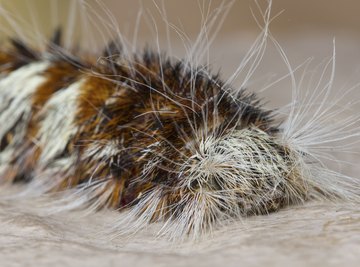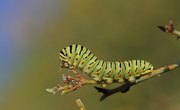
Caterpillars are the larvae of the moths and butterflies that make up the order Lepidoptera, which is the second largest group in the insect class. Many species, mostly the caterpillars that become moths, are very fuzzy creatures, while others have little or no hair. Some fuzzy caterpillars are harmless, but many cause damage to the environment and people.
Woolly Bear Caterpillars and Giant Leopard Moth
One of the more common kinds of fuzzy caterpillar is the woolly bear caterpillar that becomes the tiger moth. The black banded woolly bear, which becomes the Isabella tiger moth, is black at each end with red, orange or brown centers. The lengths of the black bands depend on how much moisture it receives.
The yellow woolly bear caterpillar that becomes the Virginia tiger moth is solid yellow to orange and is fuzzier than the black banded woolly bear. These harmless caterpillars eat grass and green plants, with the yellow woolly bears found more often on green bean plants, in gardens or on fruit trees.
Another fuzzy caterpillar similar to the banded woolly bear is the larvae of the Giant Leopard Moth. It is a nonpoisonous species with shiny black bristles and red bands between body segments. Giant leopard moth caterpillars eat leaves of many plants including violets, plantains, dandelion, cherries, maples and willows.
Tent Caterpillars
Many fuzzy caterpillars defoliate trees and plants that they use for food. Some build nests in deciduous trees and shrubs, feeding on leaves. Tent caterpillars, the larvae of tent moths, are slender and hairy. Western tent caterpillars have blue, black and orange bodies with a blue or black head. They build nests and feed on hardwood trees such as aspen, willow, mountain mahogany, cottonwoods and the bitterbush.
Eastern tent caterpillars are black with a white stripe down the back, brown and yellow lines along the sides, and a row of oval blue spots on the sides. They build nests early in the spring in the forks of branches on fruit trees, including pear, crabapple and cherry. Forest tent caterpillars have white, footprint-shaped marks down their backs with light blue stripes down the sides. They feed on deciduous trees.
Pests
The gypsy moth caterpillar, an alien species that has become naturalized in the United States, is often mistaken for a tent caterpillar. It has five pairs of blue spots and six pairs of red spots on its back and causes much damage to hardwood trees. This pest usually build its nest on trunks of deciduous trees, such as oak and ash, but have been known to eat evergreens as well. Though they aren't generally harmful to people, the hairs on gypsy moth caterpillars can cause rashes or other skin irritations on those sensitive to them.
Stinging Caterpillars
Many fuzzy caterpillars deliver extremely painful stings and burning rashes to those who touch their hair. Puss caterpillars, also known as asps, are soft, tan, slug-like caterpillars that have spines under their hair that are connected to poison sacs. They eat leaves of broad leaf shrubs and trees, including elm, apple, sycamore, oak and maple.
How to Get Rid of Fuzzy Caterpillars
Three methods exist for getting rid of caterpillars in the garden. One tactic is to hand remove caterpillars. Wear gloves and pick the caterpillars from the plants. Put them into hot water to drown or crush them. The second method, which can be especially effective, is to seek out the caterpillar egg nests and destroy them. These are spun, silk-like sacs that hang in trees and cling to leaves.
If hand removal methods don't work, treat affected plants with Bacillus thuringiensis (BT). This is a bacteria that occurs naturally in the soil. When caterpillars ingest BT, the bacteria destroys their stomach lining, causing the caterpillars to starve to death.
References
- University of Kentucky: Eastern Tent Caterpillar
- New York Department of Environmental Conservation: Tent Caterpillars and Gypsy Moths
- Hilton Pond Center: Black Bristly Caterpillar
- University of Florida, Entomology & Nematology Department: Puss Caterpillar (larva), Southern Flannel Moth (adult), Megalopyge Opercularis
Resources
About the Author
Cathryn Whitehead graduated from the University of Michigan in 1987. She has published numerous articles for various websites. Her poems have been published in several anthologies and on Poetry.com. Whitehead has done extensive research on health conditions and has a background in education, household management, music and child development.
